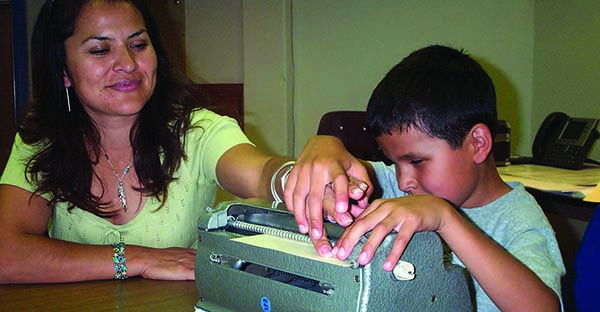In March of 2020, students and educators were required to switch from traditional in-person instruction to remote instruction very quickly. They needed to adopt and use new digital learning platforms with very little time to prepare for the transition. In fact, 81% of the educators in the first Access and Engagement study reported that they were given less than one week to prepare for the switch to remote instruction, and many educators and families described the challenges of learning to use new technology on short notice. These challenges persisted through the 2020-2021 school year. Although there was a great deal of variation in teaching models between states and local school systems, 45% of the educators surveyed reported that they were teaching fully online in August and September of 2020, with another 42% reporting teaching in a hybrid model or a combination of in-person and online instruction. By May and June of 2021, 63% of the educators surveyed were still teaching in a hybrid or blended model, using digital learning platforms to deliver instruction.
In the current study, families and educators described several technology-related challenges that prevented their students from obtaining the same access to instruction as their peers throughout online learning. The most commonly described challenges included inaccessible technology, lack of reliable access to the Internet and devices, and insufficient technology skills.
“I’ve become an advocate, it’s my job to make the world accessible until he can do it himself. I’ve developed a great deal of anger, I’m just done. The ADA’s been law for 30 years and some people don’t care.” —English-speaking parent of a 12-year-old who is blind with additional disabilities
Inaccessible Technology
During the pandemic, the students represented in our studies were often required to use multiple digital applications to access instruction and to complete assignments and assessments. For example, a student may need to use one or more videoconferencing application to meet with their teachers virtually in addition to specialized Learning Management Systems for reviewing, completing, and submitting assignments. In the second Access and Engagement study in November 2020, family members of school-aged children reported that their children had to use an average of 4.90 different digital tools to participate in hybrid or fully online learning. They reported that, on average, 2.69 of those tools were inaccessible to the child. Examples of specific accessibility challenges included:
- Programs that must be controlled by a mouse rather than a keyboard.
- Videos and pictures without text descriptions.
- Timed quizzes or games that move too quickly for the student to keep up with, preventing the student from seeing the screen.
- Devices, like Chromebooks, with screens that are too small for someone with low vision to read.
- Some programs that are accessible but not usable by all students, such as those with fine motor or cognitive disabilities.
In the current study, family members shared in detail the toll that inaccessible technology took on them and their children. Several family members described needing to sit with children through their entire school day or while completing homework because the children could not independently access the software. In other cases, children and their families chose to return to in-person education sooner than they would like because the children could not access remote instruction. Children reportedly experienced frustration and discouragement because they had lost the ability to access instruction on their own. Some children could not access technology features that were intended to promote social connection, such as chat or digital games, leading to feelings of exclusion. Representative quotes included the following:
“It has been an exciting nightmare…We did remote for both kids [one sighted child and one blind child], but our school district picked Canvas and it’s not accessible. We ended up doing hybrid for my [blind] son, I called an IEP meeting to say it wasn’t working. He came in each morning and did O&M. It was frustrating that I couldn’t protect my kids [from COVID] the way others could because of accessibility.” —English-speaking parent of a 12-year-old who is blind with additional disabilities
“They had little games that were timed, and he wasn’t on time at all. He wasn’t even in the ballpark, wasn’t on the planet…Couple times he cried in frustration not realizing his camera was on…It was that kind of stress.” —English-speaking parent of a 13-year-old who is blind
Additionally, a family with blind parents reported that they did not have the access they needed to support their young children with digital learning. The parent interviewed said:
“After schools closed…we got a packet from the classroom teacher with attached image files that were not accessible. There was no plan. We finally did get the TVI looped in, but it was honestly a cascade of awful. They said everything was optional, but optional implies we had the option to do these things, but we couldn’t access them, and neither could [our daughter].” —English-speaking parent of a 5-year-old with low vision and additional disabilities and a 3-year-old with low vision
Educators also described the challenges of adapting digital assignments to make them accessible for their students. One TVI shared: “All the students got the smallest size Chromebook possible. I was requesting a lot of extra equipment for my students because the Chromebook wasn’t accessible…. Last spring break when COVID hit, the district did a great job getting the kids equipment right away. But when they purchased for 2020–2021, the VI kids weren’t thought about. Once we could justify, they were great. It took way too long because everyone was ordering tech at the same time.” Another TVI added: “Software platforms are really inaccessible. They were made for university students. Super irritating. They should be way more accessible and a universal requirement for a school district to only purchase accessible software. Makes it so much harder for my kids to access the content.”
Both family members and educators emphasized the need to be creative and flexible in order to adapt to the limitations of educational technology and to make visually presented content accessible to students who are blind or have low vision. While the challenge of making visual content accessible was present before the pandemic, educators faced new challenges when they could not physically hand a tactile model to a student, for example. Some participants described using items around the house, yard, or neighborhood to give students hands-on experience with concepts that were presented as pictures to the rest of the class. While these efforts are admirable, accessible and usable digital learning platforms would reduce the need to develop workarounds.
Lack of Reliable Access to the Internet and Devices
“We have very poor connectivity in parts of the state. And, as a result, when we had to jump and do only virtual visits, many of our families just said, ‘Never mind, I’m just going to take a break till COVID’s over,’ thinking it would be over very quickly. And then they got out of the practice of having intervention. And I just think it’s something that we’re going to be learning from for years to come because of these children who had services interrupted.” —Administrator of a school for the blind
During the first and second Access and Engagement studies, educators consistently reported that a subset of their students were unreachable, had dropped out of remote instruction, or were on the low end of the “digital divide,” meaning that they did not have reliable access to the Internet, to devices, or to sufficient Internet bandwidth. During the first Access and Engagement study, about half of the educators reported that they could not reach at least one of their students early in the pandemic. By the second Access and Engagement study in November 2020, 42% of the educators reported being unable to reach at least 10% of their students, and 56% reported serving at least one student who was on the low end of the digital divide.
During the current study, 75% of the educators surveyed reported having at least one student on the low end of the digital divide, while 30% reported that at least 25% of their students were on the low end of the digital divide. Furthermore, when asked to describe the three most commonly encountered technology challenges over the course of the pandemic, 43% of educators reported issues related to lack of reliable Internet or Wi-Fi access as one of the most challenging issues they or their students faced. This lack of access led to inequitable service delivery, with students who had reliable Internet access receiving higher-quality, more interactive instruction than students without adequate Internet access. As one TVI explained: “For families with difficulty accessing wifi, their sessions are frequently interrupted with tech issues, whereas other families have a smoother, more robust session because the conversation is easily maintained. For some families, it is difficult for me to see the child (due to limited bandwidth for video) and so I can’t offer as many suggestions.” An O&M specialist added: “My students cannot participate in online learning with their classmates; they are completing packets at home without social interaction with peers.” A parent shared the impact of unstable Internet access on her family: “[Child] started off using his cellphone because our internet connection was very slow, especially when it was cloudy. The signal was weak. He used his phone, and then he used a laptop, but when there were connectivity issues, he had to use a cellphone.” [Spanish-speaking parent of an 11-year-old who is blind]
Another issue concerned lack of access to hardware devices. Many school districts provided devices and hotspots to students, but the devices were not always accessible. Chromebooks, for example, were frequently provided by schools, but their screens were small, difficult to enlarge, and incompatible with many screen readers. A TVI explained: “The digital divide has grown even greater for our students. The district wants to ‘solve’ all tech problems with Chromebooks, but this is not a one size fits all. Additionally, my district is focusing on more online testing…but some of these high-stakes tests are only accessible with a braille display and third-party magnification, which is not always possible with a Chromebook. There are issues with ensuring our students get braille notetakers at younger ages instead of waiting until fourth grade, which is really too late compared to peers.”
Schools and districts made efforts to accommodate students who did not have reliable access to the Internet or devices, often providing personal hotspots or setting up public areas equipped with Wi-Fi access. Schools for the blind reported giving students accessible hardware, such as iPads, and hotspots to ensure Internet access. These schools often assigned staff who were normally providing in-person services, such as bus drivers and dormitory staff, to transport materials to students’ homes, allowing these staff to remain employed during the pandemic. These solutions helped to narrow the digital divide, though it was not eliminated completely. For example, some solutions relied on families to drive students to a public location. Furthermore, even when physical access to the Internet and devices was available, family members and students did not always have the technology skills to access instruction.
Insufficient Technology Skills
“I would wonder why I didn’t ever think of telling her teachers, ‘We should give her a laptop, we should give her tools or equipment that can help her learn and have the same knowledge about technology as her peers.’ My son and daughter are around the same age. They only have a 13-month age difference, and my son uses the computer with ease. My daughter, on the other hand, doesn’t because no one took the time to say we should teach her how to use technology during school.” —Spanish-speaking parent of an 8-year-old who is blind
At the start of the pandemic, students and their families needed to master digital learning platforms very quickly. Students varied widely in the level of exposure to or training with assistive technology they had received prior to the pandemic. Some of the participants in the current study reported experiences of students who had been exposed to specialized devices such as braille notetakers, or to mobile devices, but who had limited proficiency using computers. These students often struggled to access digital learning and required high levels of support from their families and teachers to complete their coursework, or even for basic functions like logging in to a video meeting. Families, educators, and consultants expressed their support for having assistive technology instruction begin at younger ages, and be more intensive, for students who are blind or have low vision. Some representative quotes included the following:
“She has not had a lot of tech training. She was mainly trained on the BrailleSense, which wasn’t compatible with Zoom and Google Classroom. She couldn’t participate in virtual school unless I was sitting with her maneuvering the computer.” —English-speaking parent of a 16-year-old who is blind with additional disabilities
“My daughter struggled using the computer because she doesn’t have vision and aside from that, she is still very young. She doesn’t know how to use the equipment, the technology she [uses] needs to be up-to-date, and [she needs to know how to] use the laptop with [assistive technology]…When she was doing school from home, I would have to sit with her all day.” —Spanish-speaking parent of an 8-year-old who is blind
“A 2-year-old can operate an iPhone better than I can on some days. The pandemic reinforced the idea that we have to embrace the tech at a much younger age while preserving high-quality instruction for braille readers. We’re already embracing tech for low-vision kids but lagging in early braille instruction.” —State vision consultant
“So, a lot of students come here [to the school for the blind] in part because they really need to strengthen their technology skills. And so, trying to teach students how to use technology over technology that they didn’t know how to use yet, that was really, really tough.” —Administrator of a school for the blind


